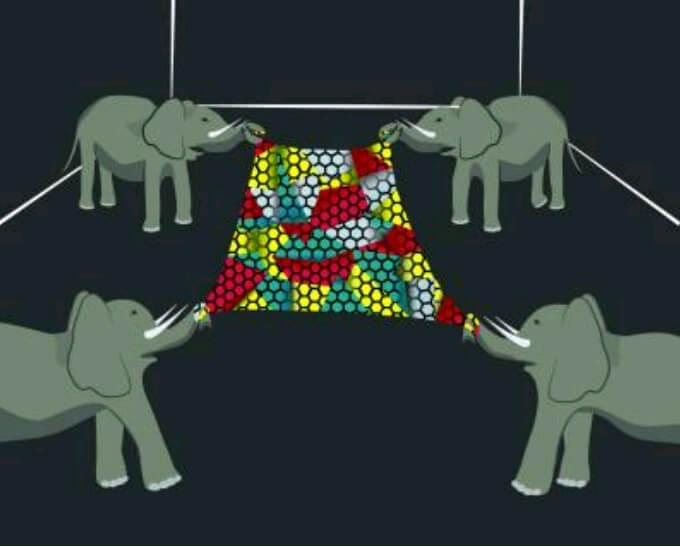In a new study, published in the journal Science, engineering researchers from Columbia University have demonstrated that the material graphene, even when it is made up of a collection of many small crystals stuck together, has a strength close to that of pure graphene.

In a new study, published in the journal Science, engineering researchers from Columbia University have demonstrated that the material graphene, even when it is made up of a collection of many small crystals stuck together, has a strength close to that of pure graphene. This research resolves the contradiction between theoretical simulations, which predicted that the boundaries of the crystals would be strong, and previous experiments that showed that they are much weaker than the pure crystal.
The material graphene consists of a single layer of carbon atoms, organized in the form of a honeycomb-like lattice. "Our first scientific paper, in 2008, tested the strength of graphene when it appears in its pure crystalline form - its inherent strength," says mechanical engineering professor James Hone. "However, completely pure graphene, without any defects, is only found in small surfaces. Wide surfaces, used in practical applications, must contain many small grains connected together by their tongues, and we did not know how strong these tongues are. Therefore, we have published our second scientific paper on the strength of large-area graphene produced using a chemical vapor deposition (CVD) method and we are excited to say that this type of graphene still remains an intrinsically strong material.”
The study proves that existing methods for processing graphene crystals prepared by the CVD method weaken the edges of the crystals and cause the weakening of the macroscopic material, as indeed observed in previous studies. In other words, the original material is strong, but weakened by the applied methods. The team of engineers from Columbia University has developed a new process that prevents any damage to graphene during its production. "We tested different edible materials and were able to create samples for testing without damaging the graphene itself," notes lead author of the paper Gwan-Hyoung Lee. "Our findings explicitly correct the widespread and erroneous opinion among scientists working in the field that the edges of the graphene crystals themselves are weak. This is exciting news because graphene provides a multitude of opportunities, both for basic and theoretical scientific research and for practical industrial applications." In its pure crystalline form, graphene is the strongest material ever measured, as Columbia engineers reported in 2008—so strong, says the lead researcher, "that only an elephant could tear through a surface of graphene the thickness of an envelope."
In their first study, the team of scientists produced small, perfectly structured flakes of graphene by mechanically exfoliating a graphene crystal. At the same time, this peeling method requires a long time and is therefore not applicable for the commercial production of graphene used for practical applications. Today, scientists can produce surfaces of graphene the size of a television screen using the CVD method, in which single layers of graphene are produced on a copper substrate in a very high-temperature furnace. One of the first applications of graphene may be an electrically conductive layer in flexible displays. "However, graphene produced by the CVD method is "glued" together from many small crystalline grains - similar to a patchwork quilt - when the edges of these grains include defects at the atomic level," explains the researcher. "These grain rims can greatly weaken the strength of graphene with a large surface since they are much more fragile than a perfect and pure crystal of graphene, a result that prompted the researchers to really test the strength of these grains."
The researchers from Columbia University wanted to find out what makes the graphene obtained by this method so weak. During the examination of the processing methods of the graphene, they discovered that the most common chemical used to remove the copper substrate is also the substance that is most harmful to the graphene, thereby weakening its strength. The experiments demonstrated that the large-grained CVD graphene is just as strong as exfoliated graphene, a finding that reinforces the evidence that the crystalline lattice itself is just as pure. And even more surprisingly, their experiments demonstrated that small-grained CVD graphene is 90% as strong as a perfect crystal.
"This is an exciting finding regarding the future of the material graphene, since it provides experimental evidence that the exceptional strength of graphene at the atomic level can be preserved at all larger macroscopic levels," explains the lead researcher. "The value of this strength will be invaluable as scientists continue to develop new flexible electronics and extremely strong composite materials."
Extensive surfaces of graphene can be used in a wide variety of applications such as flexible electronic components, mainly for television monitors that can be folded like a poster or for strong materials that could replace the carbon fibers that are common today; Or even, as futurist scientists predict, a space elevator that could connect satellites to the Earth using a long cable made up of graphene layers since this material is the only one currently known that could handle this task.

5 תגובות
Once again an invention of the left and the "academy" everyone already knows it's nonsense will not help you
It's a shame that the difference between graphite and graphene (graphene) was not detailed, and what its strength is compared to carbon fiber.
Electrical conductivity has (Wikipedia)-
Electron transport
Experimental results from transport measurements show that graphene has a remarkably high electron mobility at room temperature, with reported values in excess of 15,000 cm2·V−1·s
For those who are interested, the name in English is Graphene (phonetic: "graphene").
Simply because in Hebrew you can read "graphene" in so many ways.
In the development of D19 molecules of a graphene-type component, the resulting material loses its enzymatic conductivity and therefore becomes non-conductive and therefore not suitable for electronic displays!!